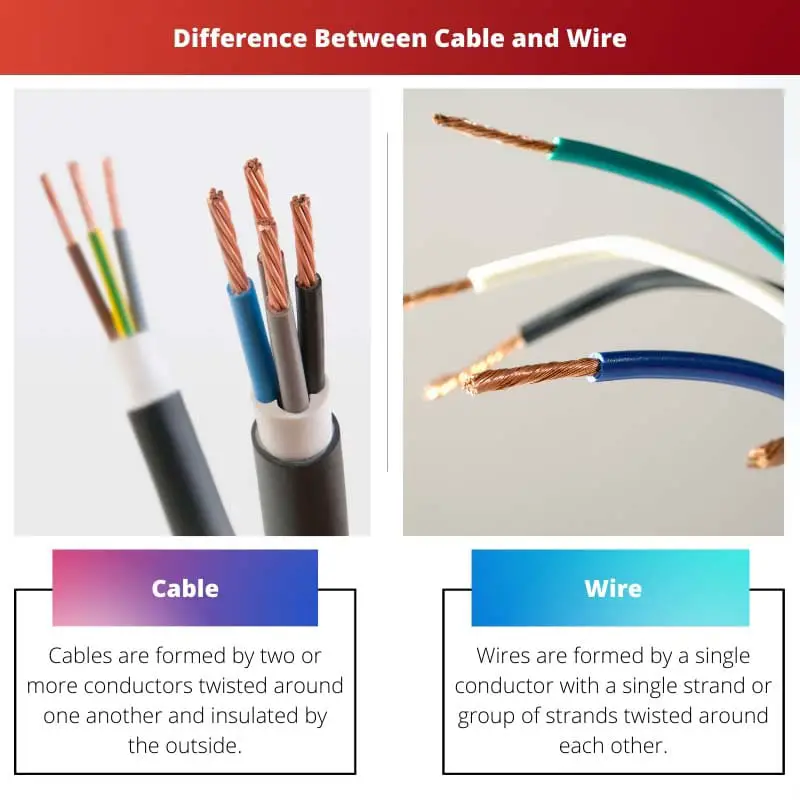Cables and wires are the most frequently used terms in electronics, telecommunications, and electrical appliances. We can say that wires are the inner component (conductors) used in the cables that are insulated inner as well as from the outer side.
The conductors are the materials commonly used in making cables and wires, strong metals like copper and aluminium as they are good conductors of electricity are preferred.
Key Takeaways
- A cable comprises multiple bundled wires, whereas a wire is a single, standalone conductor.
- Cables are used for transmitting electrical signals, data, or power, while wires are used for electrical connections and circuitry.
- Cables have insulation and protective coverings, while wires may be insulated or bare.
Cable vs Wire
A cable is a bundle of two or more insulated wires that are housed in a protective outer sheath and are used to transmit high voltage over long distances. A wire is a single strand of metal that is coated with a layer of insulation and are used for low voltage applications and short distances

Cables are formed by many wires twisted around each other forming a single layer. Cables have an internal and lateral sheath which is made for safety reasons.
Mainly there are four types of cables: twisted pair cable, coaxial cable, multi-conductor cable, and fibre-optic cable. Cables are mostly used in our day-to-day use like cable tv, telecommunication purposes, theatres, studios, etc.
Wires are formed by a single conductor (copper or aluminium). They are coated with a thin layer of polyvinyl chloride which is a synthetic plastic polymer made by a process called polymerization.
There are mainly two types of wires which is solid and stranded. Solid wires are composed of a single thin stranded conductor which is stiff and has the bendable ability.
Stranded wires are composed of many thin stranded conductors that are twisted to form a single case.
Comparison Table
| Parameters of Comparison | Cable | Wire |
|---|---|---|
| Definition | Cables are formed by two or more conductors twisted around one another and insulated by the outside. | Wires are formed by a single conductor with a single strand or group of strands twisted around each other. |
| Types | Twisted-pair cable, Coaxial cable, multi-conductor cable, and Optic-fiber cable | Solid and Stranded wire |
| Advantages | High strength, insulated, preferred for long-distance use | Higher frequency and lower resistance, cheap compared to cable |
| Disadvantages | Costly compared to wire | Big wires are not preferred for household chores |
| Uses | Telecommunications transmission, electricity impulses, carry high-frequency electricity | Household appliances, telecommunication purposes, carry low-frequency electricity |
What is Cable?
Cables are multiple stranded filaments of wire twisted together to form a single cable wire. It is insulated from both sides internally and externally as well.
There are four types of cables, each type of cable has a unique mechanism according to its purpose of use. Types of cables are as follows:
- Twisted pair cable: As the name includes, a pair (two) cables are twisted together to form a single cable.
- Coaxial cable is formed by a solid conductor internally and an outer layer with foil. Cable one is used in television media, radios, and other broadcast media.
- Multi-conductor cable: The cables are joined altogether to form a multi-conductor cable wherein it is used for the transmission of information.
- Optic-fiber cable: These are the cables made of fibres to replace metallic conductors because their bandwidth is larger than the normal cables.
Cables are used to transmit electrical impulses. These are made up of two or more wires connected. For any conceivable use, there is a vast array of cables available. Cables are commonly used in the transmission of power, electrical appliances/devices, communication purposes, etc. They are widely used in the transmission of signals to long distances, so they can be seen in television and radio transmissions.

What is Wire?
As previously stated, a wire is made of a single conductor or a collection of conductor filaments that are wrapped around each other in an insulation case to avoid undesired connections.
Wires are used for the transportation of telecommunications and electrical impulses.
Wires are divided into solid and stranded types. Solid wires are made of a long single conductor whereas stranded wires are made of two or more strands of single conductor twisted around each other.
Solid wires are preferred for higher frequencies due to their low resistivity, on the other hand, stranded wires last for a longer duration and are flexible.
As stranded wires are a group of two or more strands so they have a larger cross-sectional area compared to solid wires.
The diameter of a wire is used to determine its length. A gauge number will be assigned to the wire based on its diameter. The higher the gauge number will result in a thinner wire. The gauge number used in household appliances and devices is 10 and 20.
Big wires are used for industrial practices and should not be used for household appliances as they will damage the fuse by carrying more current into it.

Main Differences Between Cable and Wire
- Wires have a single conductor strand or a single conductor group of strands twisted around each other whereas cables are a group of conductors twisted around one another forming a single strand.
- Cables are safer than wires because they are insulated by both sides.
- In simpler words, we can say that wires are visible whereas cables are not visible due to their insulation.
- Cables have a higher strength capacity than wires. But they are more costly compared to the wires.
- Cables are used for telecommunication transmissions and carrying electrical impulses. Wires are used in day-to-day household chores to supply electricity (lights, ceiling fans, ACs, etc) and telecommunication signals.
- Cables have a longer shelf-life than wires, it is due to the insulation in the cables.

- https://www.sciencedirect.com/science/article/pii/0045794979900440
- https://www.sciencedirect.com/science/article/pii/S0883540397900073

Cables and wires can be quite confusing for many people. This post is much helpful in clearing any doubts about their nature and uses.
Great job in making such a complicated topic clear to everyone. Excellent article.
Indeed, there are many technical terms that are made easier to understand by this post.
This is a comprehensive guide to understanding cables and wires, every detail is clear and easy to understand. Thank you!
It’s surprising how little some people know about the difference between cable and wire. Good post to spread awareness about this.
I agree, it’s quite easy to confuse the two, and this article helps to clarify the differences.
There are various cables available in the market, but it’s still crucial to choose the right ones for specific purposes. Good post explaining the differences between cables and wires.
I have to disagree because sometimes cheaper cables can do the job quite effectively as well.
It would be interesting to have an explanation about the environmental impact of different types of cables and wires.
I love how you explain thoroughly the differences between cables and wires. This is a very informative post for those who aren’t familiar with the topic.
I’m not so sure about the advantages of wires. Can you provide more in-depth information on this topic?